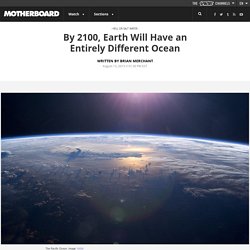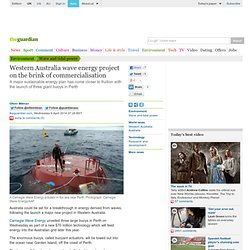

Wendy L Schultz sur Twitter : "By 2100, Earth Will Have an Entirely Different #Ocean inventory of evolving changes. By 2100, Earth Will Have an Entirely Different Ocean. The Pacific Ocean.

Image: NASA. Sorry, Everyone, Making Fuel Out of Seawater Isn't Gonna Save Humanity. This article originally appeared on VICE Australia.

Last week, some people at the US Naval Research Laboratory’s Materials Science and Technology Division were able to successfully fly an aircraft fueled by nothing but seawater. Of course, the seawater was converted into a liquid hydrocarbon "jet fuel" first, and the plane (pictured above) was a scale replica of a WWII-era fighter that even a Ken doll would find pretty cramped, but it was a pretty successful demonstration of a technology that researchers have been working on for decades now — turning the CO2 and hydrogen stored in the world’s oceans into useful fuel. How much climate-change denial can the market bear? Read more here.
Integrating Wave Energy Will Prove Relatively Simple. Clean Power Published on January 8th, 2015 | by Joshua S Hill January 8th, 2015 by Joshua S Hill Integrating large-scale wave energy into the energy grid will prove comparatively simple, thanks to its steady and reliable generation of energy, especially when compared to the inherent variability of renewable energy generation techniques like wind and solar.

A new analysis published in the journal Renewable Energy confirmed what many have already believed, that wave energy will encounter fewer problems when being integrated into existing energy grids, experiencing less variability — which can be reduced even further when wave energy production is spread out over a larger geographic area. “Whenever any new form of energy is added, a challenge is to integrate it into the system along with the other sources,” said Ted Brekken, an associate professor and renewable energy expert in the College of Engineering at Oregon State University. Satellites detect 'thousands' of new ocean-bottom mountains. Tidal Lagoon Swansea Bay. Tidal Lagoon Swansea Bay. Atlantis' MeyGen Project To Fund World’s Largest Tidal Stream Project In Scotland.
The world’s largest tidal energy project just took a big step forward as Atlantis Resources announced it has finalized an $83 million funding package for the project to break ground.

When it is finished, the 398 MW MeyGen array of underwater turbines will provide clean, sustainable, predictable power for 175,000 homes in Scotland while reducing carbon emissions. MeyGen’s parent company Atlantis Resources has managed to raise approximately £50 million which will be used to finance the initial stage of the wider MeyGen project, including the installation of four 1.5 megawatt turbines as well as the onshore infrastructure needed to support the project. When completed, the project will include up to 269 turbines submerged on the seabed, but the project’s first phase will install 61 turbines that will provide enough electricity for 42,000 homes.
Construction is expected to begin later this year, with the first electricity anticipated to be delivered to the grid by 2016. + MeyGen. New Images From The Deep Ocean. Wave and Tidal Power Hit First in Remote Communities. If you ask the people of Yakutat, Alaska, the best part about living in this small, remote town is the breathtaking natural beauty.

The worst part is the price of electricity. Yakutat's 1.5-megawatt electrical system is completely reliant on diesel fuel, which is delivered four times per year at a price of $4.50 per gallon. In recent years, the community's electricity prices have been consistently between 50 and 60 cents per kilowatt-hour. In February, according to the Department of Energy, the average residential user in the United States paid less than 12 cents per kWh.
High energy costs are threatening the very existence of the community, said Scott Newlun, general manager of Yakutat's municipally owned power plant. To try to reverse this trend, Newlun started looking for alternative ways to power his town. Western Australia wave energy project on the brink of commercialisation. Australia could be set for a breakthrough in energy derived from waves, following the launch a major new project in Western Australia.

Carnegie Wave Energy unveiled three large buoys in Perth on Wednesday as part of a new $70 million technology which will feed energy into the Australian grid later this year. Combining OTEC with floating cities? During the Seasteading Conference in San Francisco, US in May 2012 new ideas were presented for advancing seasteading, or permanent dwellings on the ocean.

According to the Randolph Hencken, the Seasteading Institute director, “the ocean provides a space to innovate with political and social systems that could advance and serve humanity”. Amongst the speakers were Robert J. Nicholson, President of OTEC International, and ocean policy expert Patrick Takahashi, Director Emeritus of the Hawaii Natural Energy Institute at the University of Hawaii.
They presented the possibilities for connecting the benefits of OTEC to floating seasteading cities in tropical oceans, supplying energy, fresh water, and enabling a new ocean ecosystem. Patrick Takahashi, spoke about his team’s vision to build the Pacific International Ocean Station (PIOS). Robert J. Patrick Takahashi about OTEC and the plan for a Pacific International Ocean Station: Robert J.
A Generator That Harnesses Energy From Ocean Currents.